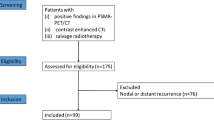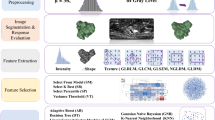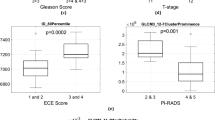Abstract
Objective
The present study aimed to investigate if CT-based radiomics features could correlate to the risk of metastatic progression in high-risk prostate cancer patients treated with radical RT and long-term androgen deprivation therapy (ADT).
Materials and methods
A total of 157 patients were investigated and radiomics features extracted from the contrast-free treatment planning CT series. Three volumes were segmented: the prostate gland only (CTV_p), the prostate gland with seminal vesicles (CTV_psv), and the seminal vesicles only (CTV_sv). The patients were split into two subgroups of 100 and 57 patients for training and validation. Five clinical and 62 radiomics features were included in the analysis. Considering metastases-free survival (MFS) as an endpoint, the predictive model was used to identify the subgroups with favorable or unfavorable prognoses (separated by a threshold selected according to the Youden method). Pure clinical, pure radiomic, and combined predictive models were investigated.
Results
With a median follow-up of 30.7 months, the MFS at 1 and 3 years was 97.2% ± 1.5 and 92.1% ± 2.0, respectively. Univariate analysis identified seven potential predictors for MFS in the CTV_p group, 11 in the CTV_psv group, and 9 in the CTV_sv group. After elastic net reduction, these were 4 predictors for MFS in the CTV_p group (positive lymph nodes, Gleason score, H_Skewness, and NGLDM_Contrast), 5 in the CTV_psv group (positive lymph nodes, Gleason score, H_Skewnesss, Shape_Surface, and NGLDM_Contrast), and 6 in the CTV_sv group (positive lymph nodes, Gleason score, H_Kurtosis, GLCM_Correlation, GLRLM_LRHGE, and GLZLM_SZLGE). The patients’ group of the training and validation cohorts were stratified into favorable and unfavorable prognosis subgroups. For the combined model, for CTV_p, the mean MFS was 134 ± 14.5 vs. 96.9 ± 22.2 months for the favorable and unfavorable subgroups, respectively, and 136.5 ± 14.6 vs. 70.5 ± 4.3 months for CTV_psv and 150.0 ± 4.2 vs. 91.1 ± 8.6 months for CTV_sv, respectively.
Conclusion
Radiomic features were able to predict the risk of metastatic progression in high-risk prostate cancer. Combining the radiomic features and clinical characteristics can classify high-risk patients into favorable and unfavorable prognostic groups.


Similar content being viewed by others
References
Gillies R, Schabath M (2020) Radiomics improves cancer screening and early detection. Cancer Epidemiol Biomarkers Prev 29:2556–2567
Schick U, Lucia F, Bourbonne V, Dissaux G, Pradier O, Jaouen V et al (2020) Use of radiomics in the radiation oncology setting: Where do we stand and what do we need? Cancer/Radiothérapie 24:755–761
Cozzi L, Comito T, Fogliata A, Franzese C, Franceschini D, Bonifacio C et al (2019) Computed tomography based radiomic signature as predictive of survival and local control after stereotactic body radiation therapy in pancreatic carcinoma. PLoS One 14:e0210758
Cozzi L, Franzese C, Fogliata A, Franceschini D, Navarria P, Tomatis S et al (2019) Predicting survival and local control after radiochemotherapy in locally advanced head and neck cancer by means of computed tomography based radiomics. Strahlenther Onkol 195:805–818
Wibmer A, Hricak H, Gondo T, Matsumoto K, Veeraraghavan H, Fehr D et al (2015) Haralick texture analysis of prostate MRI: utility for differentiating non-cancerous prostate from prostate cancer and differentiating prostate cancers with different Gleason scores. Eur Radiol 25:2840–2850
Vignati A, Mazzetti S, Giannini V, Russo F, Bollito E, Porpiglia F et al (2015) Texture features on T2-weighted magnetic resonance imaging: New potential biomarkers for prostate cancer aggressiveness. Phys Med Biol 60:2685–2701
Fehr D, Veeraraghavan H, Wibmer A, Gondo T, Matsumoto K, Vargas HA et al (2015) Automatic classification of prostate cancer Gleason scores from multiparametric magnetic resonance images. Proc Natl Acad Sci U S A 112:E6265–73
Mostafaei S, Abdollahi H, Kazempour Dehkordi S, Shiri I, Razzaghdoust A, Zoljalali Moghaddam SH et al (2020) CT imaging markers to improve radiation toxicity prediction in prostate cancer radiotherapy by stacking regression algorithm. Radiol Med 125:87–97
National Comprehensive Cancer Network (2019) NCCN clinical practice guidelines in oncology: prostate cancer 2019. Version4. http://www.nccn.org
Franzese C, Fogliata A, D’Agostino GR, Di Brina L, Comito T, Navarria P et al (2017) Moderate hypofractionated radiotherapy with volumetric modulated arc therapy and simultaneous integrated boost for pelvic irradiation in prostate cancer. J Cancer Res Clin Oncol 143:1301–1309
Yao L, Shou J, Wang S, Song Y, Fang H, Lu N et al (2020) Long-term outcomes of moderately hypofractionated radiotherapy (67.5 Gy in 25 fractions) for prostate cancer confined to the pelvis: a single center retrospective analysis. Radiat Oncol 15:231
Nioche C, Orlhac F, Boughdad S, Reuze S, Goya-Outi J, Robert C et al (2018) Lifex: A freeware for radiomic feature calculation in multimodality imaging to accelerate advances in the characterisation of tumor heterogeneity. Cancer Res 78:4786–4789
Collins GS, Reitsma JB, Altman DG, Moons KGM (2015) Transparent reporting of a multivariable prediction model for individual prognosis or diagnosis (TRIPOD): The TRIPOD Statement. Eur Urol 67:1142–1151
Youden WJ (1950) Index for rating diagnostic tests. Cancer 3:32–35
RDCT (2018) A Language and Environment for Statistical Computing. R Found. Stat. Comput., vol. 2. https://www.R-project.org
Moris L, Cumberbatch MG, Van den Broeck T, Gandaglia G, Fossati N, Kelly B et al (2020) Benefits and risks of primary treatments for high-risk localized and locally advanced prostate cancer: an international multidisciplinary systematic review. Eur Urol 77:614–627
Bolla M, Collette L, Blank L, Warde P, Dubois JB, Mirimanoff RO et al (2002) Long-term results with immediate androgen suppression and external irradiation in patients with locally advanced prostate cancer (an EORTC study): A phase III randomised trial. Lancet 360:103–108
Ramón y Cajal S, Sesé M, Capdevila C, Aasen T, De Mattos-Arruda L, Diaz-Cano SJ et al (2020) Clinical implications of intratumor heterogeneity: challenges and opportunities. Mol Med 98:161–177
Caswell DR, Swanton C (2017) The role of tumour heterogeneity and clonal cooperativity in metastasis, immune evasion and clinical outcome. BMC Med 15:133
Schweizer MT, Zhou XC, Wang H, Yang T, Shaukat F, Partin AW et al (2013) Metastasis-free survival is associated with overall survival in men with PSA-recurrent prostate cancer treated with deferred androgen deprivation therapy. Ann Oncol 24:2881–2886
Bosetti DG, Ruinelli L, Piliero MA, van der Gaag LC, Pesce GA, Valli M et al (2020) Cone-beam computed tomography-based radiomics in prostate cancer: a mono-institutional study. Strahlenther Onkol 196:943–951
Osman S, Leijenaar R, Cole A, Lyons C, Hounsell A, Prise K et al (2019) Computed tomography-based radiomics for risk stratification in prostate cancer. Int J Radiat Oncol Biol Phys 105:448–456
Tanadini-Lang S, Bogowicz M, Veit-Haibach P, Huellner M, Pauli C, Shukla V et al (2018) Exploratory radiomics in computed tomography perfusion of prostate cancer. Anticancer Res 38:685–690
Bautista J, Houshyar R, Verma S, Uchio E, Lall C (2016) Prostate cancer on computed tomography: a direct comparison with multi-parametric magnetic resonance imaging and tissue pathology. Eur J Radiol 85:261–267
Kim B, Kawashima A, Ryu J, Takahashi N, Hartman R, King B (2009) Imaging of the seminal vescicle and vas deferens. Radiographics 29(4):1105–1121
Glazer D, Davenport M, Khalatbari S, Cohan R, Ellis J, Caoili E et al (2015) Mass-like peripheral zone enhancement on CT is predictive of higher grade (Gleason 4+3) and higher prostate cancer. Abdom Imaging 40(3):560–570
Delgadillo R, Ford JC, Abramowitz MC, Dal Pra A, Pollack A, Stoyanova R (2020) The role of radiomics in prostate cancer radiotherapy. Strahlenther Onkol 196:900–912
Gugliandolo SG, Pepa M, Isaksson LJ, Marvaso G, Raimondi S, Botta F et al (2020) MRI-based radiomics signature for localized prostate cancer: a new clinical tool for cancer aggressiveness prediction? Sub-study of prospective phase II trial on ultra-hypofractionated radiotherapy (AIRC IG-13218). Eur Radiol 31:716–728
Gnep K, Fargeas A, Gutiérrez-Carvajal RE, Commandeur F, Mathieu R, Ospina JD et al (2017) Haralick textural features on T 2 -weighted MRI are associated with biochemical recurrence following radiotherapy for peripheral zone prostate cancer. J Magn Reson Imaging 45:103–117
Author information
Authors and Affiliations
Corresponding author
Ethics declarations
Conflict of interest
L. Cozzi acts as scientific advisor to Varian Medical Systems and is a clinical research scientist at Humanitas Cancer Center. C. Franzese, M. Badalamenti, D. Baldaccini, G. D’agostino, A. Fogliata, P. Navarria, D. Franceschini, T. Comito, E. Clerici, G. Reggiori, S. Tomatis, and M. Scorsetti declare that they have no competing interests.
Ethical standards
Ethics approval: the Ethics Committee of the Humanitas Cancer Center approved by notification this retrospective study. Consent to participate: all patients provided consent for retrospective studies at hospital admission.
Additional information
Availability of data and material
Data and material are available upon request to the corresponding author.
Rights and permissions
About this article
Cite this article
Franzese, C., Cozzi, L., Badalamenti, M. et al. Radiomics-based prognosis classification for high-risk prostate cancer treated with radiotherapy. Strahlenther Onkol 198, 710–718 (2022). https://doi.org/10.1007/s00066-021-01886-y
Received:
Accepted:
Published:
Issue Date:
DOI: https://doi.org/10.1007/s00066-021-01886-y




